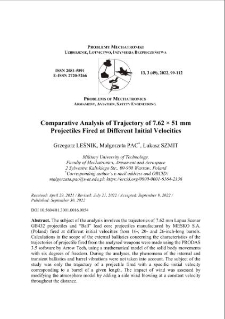Our Digital Library contains 1 868 digital objects
Object
Title: Comparative Analysis of Trajectory of 7.62 × 51 mm Projectiles Fired at Different Initial Velocities
Alternative title:
Analiza porównawcza torów pocisków 7,62 × 51 mm wystrzelonych z różnymi prędkościami początkowymi
Contributor:
Abstract:
The subject of the analysis involves the trajectories of 7.62 mm Lapua Scenar GB432 projectiles and “Ball” lead core projectiles manufactured by MESKO S.A. (Poland) fired at different initial velocities from 16-, 20- and 26-inch-long barrels. Calculations in the scope of the external ballistics concerning the characteristics of the trajectories of projectile fired from the analysed weapons were made using the PRODAS 3.5 software by Arrow Tech, using a mathematical model of the solid body movements with six degrees of freedom. During the analyses, the phenomena of the internal and transient ballistics and barrel vibrations were not taken into account. The subject of the study was only the trajectory of a projectile fired with a specific initial velocity corresponding to a barrel of a given length. The impact of wind was assessed by modifying the atmosphere model by adding a side wind blowing at a constant velocity throughout the distance. The results allowed the analysis of the effect of the barrel length and the associated initial velocity of the projectile on the nature of the projectile trajectory, especially the obtained overheight path and projectile range. The impact of the side wind on different types of projectiles was also assessed. When shooting precision rifles, it is better to use rounds with heavy projectiles, optimized for long-distance shooting. Lightweight-projectile rounds can be successfully used in the semi-automatic rifles used for support at the lowest levels, where more manoeuvrability (including barrels with a length not exceeding 20 inches) and higher fire rate is required, and, at the same, where shooting at distances exceeding 500 m is not necessary. Lightweight-projectile rounds can also be successfully used for marksmanship training at distances below 500 m, where the differences between the trajectories of different projectiles are the least.
Place of publishing:
Warszawa
Publisher:
Date created:
Date submitted:
Date accepted:
Date issued:
Extent:
Identifier:
oai:ribes-88.man.poznan.pl:2649
Call number:
Electronic ISSN:
Print ISSN:
Language:
License:
Rights holder:
Starting page:
Ending page:
Volume:
Keywords:
mechanics, ammunition, ballistics, small arms, rifle
Object collections:
Last modified:
Oct 13, 2025
In our library since:
Oct 13, 2025
Number of object content hits:
0
All available object's versions:
https://ribes-88.man.poznan.pl/publication/2978
Show description in RDF format:
Show description in OAI-PMH format:
| Edition name | Date |
|---|---|
| Comparative Analysis of Trajectory of 7.62 × 51 mm Projectiles Fired at Different Initial Velocities | Oct 13, 2025 |
Objects Similar
Łukasz SZMIT Mirosław ZAHOR
Grzegorz LEŚNIK Józef GACEK
Grzegorz LEŚNIK Józef GACEK
Grzegorz LEŚNIK

